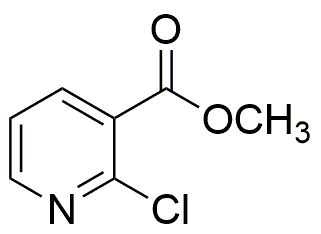Methyl 2-chloronicotinate is widely utilized in research focused on:
- Synthesis of Pharmaceuticals: This compound serves as an important intermediate in the synthesis of various pharmaceuticals, particularly those targeting neurological disorders. Its unique structure allows for the development of drugs with enhanced efficacy.
- Agricultural Chemicals: It is used in the formulation of agrochemicals, including herbicides and insecticides, providing effective solutions for pest control while minimizing environmental impact.
- Material Science: Methyl 2-chloronicotinate is employed in the development of advanced materials, such as polymers and coatings, which offer improved durability and resistance to degradation.
- Research in Organic Chemistry: Researchers utilize this compound in various organic synthesis reactions, facilitating the creation of complex molecules and contributing to advancements in chemical research.
- Biochemical Applications: It is also explored for its potential in biochemical assays and studies, aiding in the understanding of biological processes and interactions at the molecular level.
General Information
Properties
Safety and Regulations
Applications
Methyl 2-chloronicotinate is widely utilized in research focused on:
- Synthesis of Pharmaceuticals: This compound serves as an important intermediate in the synthesis of various pharmaceuticals, particularly those targeting neurological disorders. Its unique structure allows for the development of drugs with enhanced efficacy.
- Agricultural Chemicals: It is used in the formulation of agrochemicals, including herbicides and insecticides, providing effective solutions for pest control while minimizing environmental impact.
- Material Science: Methyl 2-chloronicotinate is employed in the development of advanced materials, such as polymers and coatings, which offer improved durability and resistance to degradation.
- Research in Organic Chemistry: Researchers utilize this compound in various organic synthesis reactions, facilitating the creation of complex molecules and contributing to advancements in chemical research.
- Biochemical Applications: It is also explored for its potential in biochemical assays and studies, aiding in the understanding of biological processes and interactions at the molecular level.
Documents
Safety Data Sheets (SDS)
The SDS provides comprehensive safety information on handling, storage, and disposal of the product.
Product Specification (PS)
The PS provides a comprehensive breakdown of the product’s properties, including chemical composition, physical state, purity, and storage requirements. It also details acceptable quality ranges and the product's intended applications.
Certificates of Analysis (COA)
Search for Certificates of Analysis (COA) by entering the products Lot Number. Lot and Batch Numbers can be found on a product’s label following the words ‘Lot’ or ‘Batch’.
*Catalog Number
*Lot Number
Certificates Of Origin (COO)
This COO confirms the country where the product was manufactured, and also details the materials and components used in it and whether it is derived from natural, synthetic, or other specific sources. This certificate may be required for customs, trade, and regulatory compliance.
*Catalog Number
*Lot Number
Safety Data Sheets (SDS)
The SDS provides comprehensive safety information on handling, storage, and disposal of the product.
DownloadProduct Specification (PS)
The PS provides a comprehensive breakdown of the product’s properties, including chemical composition, physical state, purity, and storage requirements. It also details acceptable quality ranges and the product's intended applications.
DownloadCertificates of Analysis (COA)
Search for Certificates of Analysis (COA) by entering the products Lot Number. Lot and Batch Numbers can be found on a product’s label following the words ‘Lot’ or ‘Batch’.
*Catalog Number
*Lot Number
Certificates Of Origin (COO)
This COO confirms the country where the product was manufactured, and also details the materials and components used in it and whether it is derived from natural, synthetic, or other specific sources. This certificate may be required for customs, trade, and regulatory compliance.


